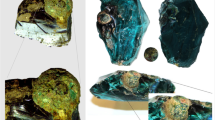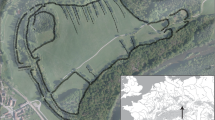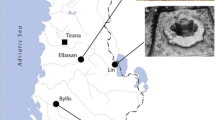Abstract
Medieval artifacts made of glass are at a serious disadvantage concerning the chemical stability compared with ancient or common modern glasses. The total amount of silica and other network formers such as alumina is very low and potassium instead of sodium was introduced into the silicate structure by using local raw material. By means of scanning electron microscopy (SEM), secondary ion mass spectrometry (SIMS) and nuclear reaction analysis (NRA) a weathering mechanism governed by an ion exchange process could be determined for medieval glass paintings exposed to the ambient air for centuries. Additionally, the leached glass surface of medieval hollow glass artifacts found in a well and exposed to moist earth show a brown discoloring due to the oxidation of Mn(II) to Mn(IV) oxide. That process can be converted by a treatment of the glass objects in an aqueous hydrazine solution.
Similar content being viewed by others
References
M. A. Bezborodov,Chemie und Technologie der antiken und mittelalterlichen Gläser, Philipp von Zabern, Mainz, 1975.
S. Frank,Glass and Archaeology, Academic Press, London, 1982.
B. C. Bunker, G. W. Arnold, E. K. Beauchamp, D. E. Day,J. Non-Cryst. Solids 1983,58, 295.
H. Scholze,J. Non-Cryst. Solids 1982,52, 91.
F. M. Ernsberger,Phys. Chem. Glasses 1980,21/4, 146.
G. Frenzel,Sci. Am. 1985,252/5, 100.
R. Collongues, M. Perez y Jorba, G. Tilloca, J. P. Dallas,Verres Refract. 1976,30/1, 43.
R. G. Newton,The Deterioration and Conservation of Painted Glass—A Critical Bibliography, Oxford University Press, Oxford, 1982.
J. S. K. Gillies, G. A. Cox,Glastech. Ber. 1988,61/3, 75;1988,61/4, 101.
G. A. Cox, O. S. Heavens, R. G. Newton,J. Glass. Stud. 1979,21, 54.
G. Nauer, E. Kny,Glastech. Ber. 1983,56K, 656.
M. Schreiner,Glastech. Ber. 1988,61/7, 297.
W. Geilmann, H. J. Berthold, G. Tölg,Glastech. Ber. 1960,33/6, 213.
M. Schreiner, G. Stingeder, M. Grasserbauer,Fresenius' Z. Anal. Chem. 1984,319, 600.
M. Schreiner, M. Grasserbauer, P. March,Fresenius' J. Anal. Chem. 1988,331, 428.
I. Bauer,Analytische Untersuchungen zur Korrosion von Kalk-Kali-Silicatgläsern (Diplomarbeit), Technical University, Vienna, 1990.
A. Salem, M. Schreiner, Ch. Weigl, R. Kellner,EUROANALYSIS VII (Book of Abstracts, A5 P-Fr-055), Vienna, 1990.
M. Schreiner, B. Cech,Scientific Investigations of Medieval Hollow Glass, Proceedings of Int. Sympos. on Archaeometry, Heidelberg, 1990, p. 73.
S. Fitz,A New Method of Cleaning Browned Medieval Glass, Proc. 6th Triennial Meeting, Ottawa, 1981, 81/20/5, ICOM-Committee for Conservation.
W. Müller, H. Pouillon, G. Bochynek, H. Mehner,Glastech. Ber. 1986,59/4, 96.
Author information
Authors and Affiliations
Rights and permissions
About this article
Cite this article
Schreiner, M. Glass of the past: The degradation and deterioration of medieval glass artifacts. Mikrochim Acta 104, 255–264 (1991). https://doi.org/10.1007/BF01245513
Received:
Issue Date:
DOI: https://doi.org/10.1007/BF01245513




